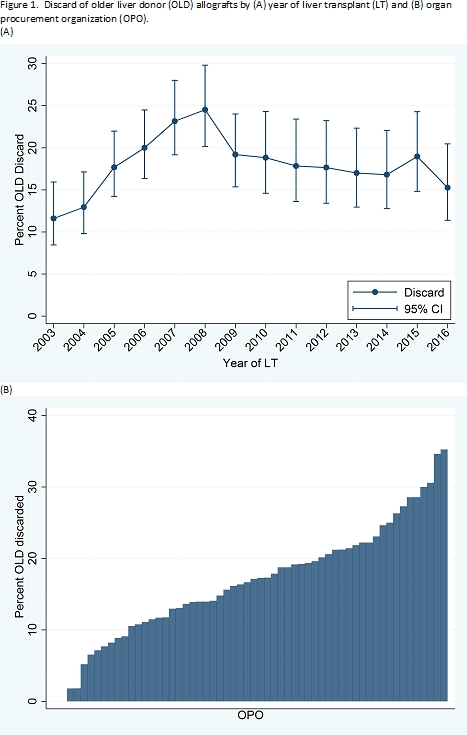Trends in Liver Transplantation with Older Liver Donors in the United States
Surgery, JHU, Baltimore.
Meeting: 2018 American Transplant Congress
Abstract number: 423
Session Information
Session Name: Concurrent Session: Donor Management: All Organs Excluding Kidney
Session Type: Concurrent Session
Date: Tuesday, June 5, 2018
Session Time: 2:30pm-4:00pm
 Presentation Time: 3:42pm-3:54pm
Presentation Time: 3:42pm-3:54pm
Location: Room 3AB
As the US population ages, older liver donors (OLDs) represent a potential expansion of the donor pool. Historically, grafts from OLDs have been associated with poor outcomes and higher rates of discard, but recent studies reported equivalent outcomes to grafts from younger donors. We sought to identify trends in demographics, discard, and outcomes of OLDs.
METHODS: We identified 4127 OLDs (aged≥70) and 3350 liver-only OLD graft recipients using SRTR data (2003-2016). We studied temporal changes in OLD graft characteristics, utilization, and recipient characteristics. Modified Poisson regression was used to estimate OLD discard. Cuzick test of trend was used to compare changes in number of OLD transplants. Cox proportional hazards were used to estimate mortality and graft loss for OLD recipients.
RESULTS: From 2003 to 2016, the discard of OLDs increased from 11.6% to 15.4% with highest discard in 2008 at 24.5%. Since 2003 the percentage of OLD transplants performed out of all adult liver transplants decreased from 6.0% to 3.2% (p=0.001). Recently transplanted OLDs were more likely to have shorter cold ischemia and come from donors with higher BMI compared to 2003. Recent OLD recipients were more likely to be older and to receive shared organs. For OLD graft recipients from 2013-2016, mortality was 60% lower (0.40,95%CI:0.31-0.52,p<0.001) and all-cause graft loss was 55% lower (0.45,95%CI:0.36-0.57,p<0.001) than between 2003-2006.
CONCLUSION: Up to 25% of OLDs are discarded annually across the US, and the number of OLD transplants performed has decreased. However, there is a significant improvement in graft and patient survival for OLD recipients since 2003. Particularly in the setting of an aging population, these trends in improved outcomes can guide OLD use and decrease OLD discard to possibly expand the donor pool.

CITATION INFORMATION: Haugen C., Luo X., Thomas A., Holscher C., Garonzik-Wang J., McAdams-DeMarco M., Segev D. Trends in Liver Transplantation with Older Liver Donors in the United States Am J Transplant. 2017;17 (suppl 3).
To cite this abstract in AMA style:
Haugen C, Luo X, Thomas A, Holscher C, Garonzik-Wang J, McAdams-DeMarco M, Segev D. Trends in Liver Transplantation with Older Liver Donors in the United States [abstract]. https://atcmeetingabstracts.com/abstract/trends-in-liver-transplantation-with-older-liver-donors-in-the-united-states/. Accessed December 14, 2025.« Back to 2018 American Transplant Congress
